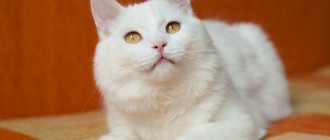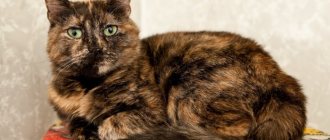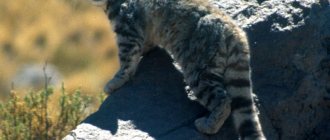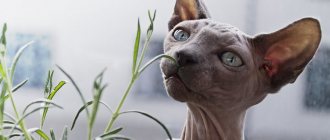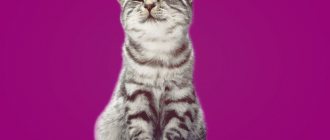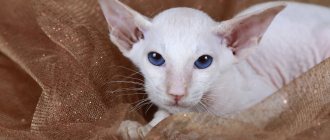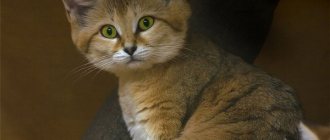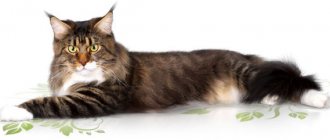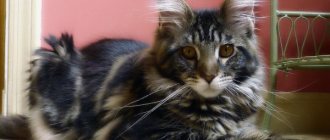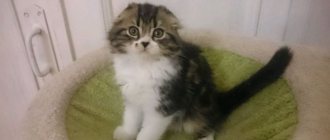Lykoy cat werewolf
Likoi - scary on the outside, kind on the inside
The appearance of a Lykoi cat often raises concerns about its health and adequacy. The roan, half-bald creature only vaguely resembles a domestic purr. Hence the name. Translated from ancient Greek, λύκοι means wolf, and werewolves were called lycontropes in Europe.
Lykoi appeared as a result of a natural mutation in the hair of the domestic shorthaired cat, which was subsequently fixed through competent selection.
Lykoi's fur feels like human hair. It is rare and completely devoid of undercoat. The color is atypical for cats - roan (the ideal ratio of black and white hair is 50/50). At the same time, the werewolf cat is partially naked, which adds to her resemblance to a mystical creature. No pathologies or genetic abnormalities were identified in the breed.
It is interesting that there are long queues for kittens from the best nurseries. They cost an average of $1,500.
Features and genetics of color
The coat looks gray with unevenly distributed black pigment. If you look at a hair under a microscope, you can see that there are white spaces between the black areas. The amount of carbon pigment in the bulb itself does not affect the color: gray cats have the same amount of it as black cats. An ashy shade is obtained when eumelanin fills only part of the pigment cells of the hair, and some remain uncolored. In this case, filled and empty cells alternate not one at a time, but in small clusters. The ratio of the sizes of the white and black zones on the hair determines how light the shade will be.
If the light area is at the tips of the bristles, a silvery tint appears in the color.
Gray cats are carriers of the dominant black gene. Genetically, their difference from black cats is not associated with the white gene - this gene is the strongest of all, and if it is dominant, regardless of the set, a white kitten is born. The difference in color is due to the color density gene. Being dominant, it determines uniform staining of cells and vice versa. That is, in gray cats, unlike black cats, it is recessive.
A solid gray color, without spots or stripes, is called blue. It is possessed by cats that do not have the dominant agouti gene that determines the pattern. The eyes of these cats are usually brown, yellow or green. The nose and pads on the paws often have a gray-blue tint.
If the genes for black color and density turn out to be recessive, and there is no dominant red gene responsible for the orange pigment (pheomelanin), the gray coat color will have a warm tone. This color, if solid, is called lilac.
The undercoat of gray wool can be light, even white. This gray-white cat has a smoky coloration.
Toyger
Domestic mini tiger
A young American breed of domestic cats with an original striped color. The breed was developed in the USA in the late 80s by crossing Bengal cats and domestic shorthairs of an atypical merle color.
The new breed was born thanks to the efforts of Judy Sugden, the daughter of the world-famous felinologist Jean Mill (Sugden), who bred the Bengal cat. The name of the breed is formed by merging the English words toy - toy and tiger - tiger.
Judy was working on improving the color of her marbled Bengals when she noticed that one of her pets had spots on her temples that looked like arrows. It took a long time to choose a groom for this cat. As a result, he became a street cat brought from Kashmir, India. He had unusual stripes on his ears. Two such insignificant, at first glance, details made it possible to obtain a circular striped tabby color. It is not found in any other domestic cat.
Toygers are affectionate and friendly, very energetic and playful until old age. Their habits are no different from ordinary cats, but their color is admirable. The breed is considered rare and expensive throughout the world. A kitten from a nursery costs an average of $1,800.
Varieties of colors
How many cats - so many fur coats. Breeders are constantly experimenting with colors. They cross two parents with the desired traits and strive to imprint some exotic shade in the offspring. In this case, an arbitrary uncontrolled mutation occurs along the way, which can radically change the appearance of the animal.
It has been noticed that many breeds of tabby cats have a stable nervous system and good health. No one has yet proven a direct relationship with the type of color, but scientists are also in no hurry to deny it.
The tabby allele is located on the cat chromosome 1X, which is responsible for the immune system. A random change in the established order can destroy the natural balance.
The cat with dark stripes is found in many breeds. This pattern is also called tiger because of its external resemblance to a wild predator. The only difference is the base coat color, but the gray tabby's pattern looks identical.
Distinctive features:
- the neck is girded with narrow lines;
- thin stripes of varying lengths are located throughout the body;
- the tail is ringed along the entire length or most of it.
The name of the color must indicate the color of the ornament, and not the characteristics of the coat:
- Black tabby cat with dark lines on its skin.
- Red brindle with a pattern in shades of red.
- The blue brindle is painted with blue-gray strokes.
- The brown tabby cat has a chocolate-colored labyrinth on his skin.
Gray tabby cat species are found primarily in native breeds. Their appearance corresponds to the conditions of natural selection, living in a certain area in a natural climatic environment.
But it is almost impossible to find a pet with stripes of exotic colors (fawn, cinnamon, lilac) among gray purebred cats.
Munchkin
Munchkin - the “dachshund” in the cat world
The breed in question is one of the most discussed in the cat kingdom, and its main distinguishing feature is its very short legs. Munchkins like to sit on their hind legs, like gophers, and often grasp objects with their front legs. They are jokingly called dachshund cats or simply shorties. They conquered the world so quickly that the term “munchkinomania” even appeared on the Russian-speaking Internet.
It is known that short-legged cats were bred in the 30s in England. Then 4 generations of shorties were born. But the Second World War made its own adjustments and the breed could not be preserved. The modern history of munchkins began in the early 80s, when American Sandra Hochenedel from Louisiana picked up a black and white pregnant cat with short legs on the street and named her Blackberry. Of several kittens, one inherited its mother's feature. They named him Tuluus. Blackberry and her own son became the bosses of all modern munchkins.
The breed owes its name to the short magical people described in the book “The Wizard of Oz.” Munchkins have given rise to several new experimental breeds.
The Munchkin's body is slightly elongated, its legs are 2-3 times shorter than those of an ordinary cat. They are playful, cheerful and loving creatures by nature, who are not upset if they cannot jump on a high table, but find other exciting fun on the floor. Prices fluctuate within a very wide range.
What are the smallest cat breeds in the world? | TOP 15
The smallest cat on Earth is Scythe-toy-bob. Representatives of this breed weigh up to 1.5 kilograms. This is a highly trainable and playful breed.
There are about 300 cat breeds. They differ in color, size, character. The weight of some breeds is only 900 grams. Such animals attract with their funny appearance and playful character. Until old age they look like kittens.
The TOP 15 list includes the following small cat breeds:
- skiff-toy-bob;
- rusty;
- munchkin;
- Napoleon;
- bambino;
- Lamkin;
- Skookum;
- Dwelf;
- Singaporean;
- minskin;
- Kinkaloe;
- American Curl;
- Devon Rex;
- Balinese;
- Abyssinian
Let's look at each small breed separately.
Skif-toy-bob: weight 1.5 kilograms
The smallest cat is Skiff-toy-bob. Its representatives weigh from 900 grams to 1.5 kg. The breed is considered the smallest of the cats. Also called skif-tay-don. Cats whose weight does not exceed 1 kilogram are especially valued. It is believed that the miniature nature of this breed is due to a recessive mutation.
Externally, Scythian Tay-dons resemble Siamese cats. They have blue eyes. The coat is silky and smooth. Color white. The tail, ears, tips of the paws and the front of the muzzle are dark gray. A distinctive feature of this breed is its very short tail, like for a cat. Skiff toy bobs are also called dwarf bobtails.
By nature, cats are cunning, playful and cheerful. They remain active until old age. They strive to subjugate other pets and the owner. Interestingly, dwarf bobtails are not afraid of flash and fire. They respond well to training.
Rusty cat: weight 1.6 kilograms
The rusty or spotted ginger cat is a miniature specimen of the wild. Today, many exotic lovers have unusual animals in their homes. And some choose a rusty cat.
The breed is also called spotted. Its representatives grow from 1 to 1.6 kg. Cats are characterized by small protruding ears and large eyes. The expression on the muzzle is always confused. But this is a deceptive feeling. The rusty cat gets along well in the wild and is a good hunter. Her fur and voice are pleasant, unlike other wild animals. The color is interesting. Somewhat reminiscent of Bengal cats. But the colors are duller.
Rusty cats live in India and Sri Lanka. They are not afraid of water and easily cross streams. The breed is rare. The whole reason is deforestation and other unfavorable factors. Only about 10,000 rusty specimens remain. Therefore, today the breed is in the Red Book.
In the wild world, the rusty cat is a merciless hunter. But in the hands of a person it turns into a harmless and very affectionate pet. But keeping a cat in a zoo or at home somewhat weakens the immune system. In the wild, such animals live longer.
Dwelf: weight 3 kilograms
This is a hairless cat breed. Dwelfs have a long body and short legs. They have huge blue eyes and large ears with curved ends. Dwelfs are unlike any other cat breed. They were obtained by crossing Sphynxes, Munchkins and American Curls. The weight of Dwelfs varies around 1.5-3 kg. Cats are friendly, loyal and sociable. They need the owner's attention. If it is deficient, they may become depressed.
Singapura cat: weight 3 kilograms
Such cats grow up to three kilograms. They have a graceful face. The coat is medium in length. It fits tightly to the body, smooth. Singapura cats have almond-shaped eyes. The tail is thin. The coat is short. The cats look attractive and elegant. They are considered a talisman among Singaporeans.
By nature, the animals are independent, active and non-aggressive. They are curious. But they don't cause any trouble.
Minskin: weight 3 kilograms
Representatives of this breed grow up to three kilograms. They were obtained by crossing a Burmese, a Sphynx and a Devon Rex. The appearance is very unusual. Wool is present. It is thick and dense. But it grows only in certain areas. It is practically absent from the body. There is fur on the belly, paws, ears and head. May be on the hips and shoulders. The ears of Minskins are very large and triangular. The tail is long. By nature, cats of this breed are playful and good-natured.
Kinkaloo: weight 3 kilograms
The breed was obtained by combining short-legged munchkins with American curls. The weight of kinkalow varies between 2-3 kg. The ears are small, round in shape, and curved inward. The coat is smooth. The tail is fluffy and long.
Kinkalows are active, inquisitive and friendly. With such a cat at home you will definitely not be bored.
Munchkin: 3.5 kilograms
This is a breed of short-haired cat. Kittens grow up to 3.5 kg. Munchkins have a long body. They are active. They love to climb cabinets and sit on top shelves. But they don’t always get off on their own. All because of very short legs. They are 2-3 times shorter than those of ordinary cats.
Munchkins love to create hiding places. They hide their toys and objects they like in secluded places. To look around, short-legged cats stand on their hind legs. They can stay in this position for quite a long time.
An interesting fact is that munchkins were not selected. The breed appeared naturally. These cats look very funny. Therefore, many today take them as a basis. For example, thanks to munchkins, the Minskin breed was created.
By nature, such cats are friendly and good-natured. They easily make contact with strangers and other pets. Aggression is not typical for them.
Skookum: weight 3.5 kilograms
The Skookum breed was created by crossing La Perms with Munchkins. The weight of its representatives does not exceed 3.5 kg.
Skookum cats have fluffy, curly fur. Therefore, in appearance they somewhat resemble cute lambs. Their legs are short. The animal is playful, friendly, and inquisitive. Remains active until old age. It gets along well in the same territory with other animals.
Napoleon: weight 4 kilograms
Representatives of this breed grow from 2.5 to 4 kg. Cats have short legs. The body is covered with long thick hair. The tail is very fluffy. Napoleons have a flattened muzzle. The eyes are large and expressive. Color white, red, tricolor, striped. Purebred representatives of Napoleons are very expensive - 35,000-80,000 rubles. Therefore, not everyone can afford such a cat.
Bambino: weight 4 kilograms
Bambino cats grow up to 2-4 kg. The name of the breed is of Italian origin. Means a small child. And it completely justifies itself. Bambinos look funny and cute. Playful in nature. They remain active and lively until old age.
Canadian Sphynxes and Munchkins were used to breed the breed. It was from them that the bambino inherited its unusual appearance. Representatives of this breed do not have hair. They have large eyes and triangular ears. The legs are short. The color can be white, white-gray, gray, gray-pink.
Lamkin: weight 4 kilograms
Translated, lemkin means lamb. This name of the breed fully justifies itself. Its representatives have fluffy, curly fur. The legs are short. The tail is of medium length. All their lives, lambkins look like funny little kittens. Their weight does not exceed four kilograms.
The breed was created by combining the Selkirk Rex and the Munchkin. Lamkin cats are curious, playful and active. They constantly demand attention to themselves.
Balinese cat: 4 kilograms
Balinese or Balinese cats grow up to four kilograms. Representatives of this breed have well-developed muscles. At the same time, they look elegant and aristocratic. They have a long bushy tail with a pointed tip. The coat is shiny. There is practically no undercoat. The paws are long. The eyes are almond-shaped. The neck is elongated. The point color is traditional.
The breed was obtained by American breeders. When breeding it, Siamese cats were used. Balinese representatives are distinguished by their slimness and gracefulness. Animals get along well with humans. Some even go for walks with their owner. Balinese cats have a friendly character.
American Curl: weight 4.5 kilograms
American curls grow up to 4.5 kg. They have curled small ears. An interesting fact is that kittens of this breed are born with straight ears. But already in the first week of life, the ears begin to curl.
American Curls have a wedge-shaped head, with a well-defined and strong chin. The eyes are big. Their shape is elongated oval. The body of such cats is well-fed, dense, but at the same time elegant. Paws of medium length, straight. The tail according to the standard corresponds to the length of the body.
American Curls are friendly and playful. They love children very much. They are never offended. Animals are active. Therefore, they are not suitable for those who prefer a calm and measured lifestyle.
Devon Rex: weight 4.5 kilograms
Devon rexes grow up to 2.3-4.5 kg. The birthplace of the breed is Great Britain. Cats are distinguished by large splayed ears and large eyes. Very graceful. Outwardly they look like Martians. The head is small wedge-shaped. The antennae are small and curled. The body is graceful and flexible. The legs are very long and slender. The tail is thin, with a rounded tip.
Devon rexes do not shed. Their fur is hypoallergenic. Soft and curly. Such animals are perfect for those who are hypersensitive to cat hair. Cats are cheerful and active by nature.
Abyssinian cat: weight 4.5 kilograms
Representatives of this cat breed grow to a maximum of 3-4.5 kg. The animal is graceful, flexible and graceful. Harmoniously put together. The paws are long. The muscles are well developed. The ears are large, triangular. The eyes are large almond-shaped. The neck is long and graceful. The coat is short. Has an interesting color. There are red, blue and wild colors.
By nature, Abyssinian cats are narcissistic. They love admiration and praise. Very mobile. They try to be in several places at the same time. At the same time, they are balanced and devoted to their owner. Abyssinian cats are very smart. They get along with children.
American Curl
The American Curl's ears can be curled back to varying degrees, the more, the more valuable he is.
A breed of semi-longhaired cats with unique curled back ears. The first American Curls appeared in 1981 from an ordinary black cat named Shulamith, living in California.
Kittens are born with straight ears, which begin to curl within 48 hours and take up to 3-4 months to develop. In adult cats, they should be firm and stiff to the touch at the base, but with flexible tips.
The American Curl gave rise to several new breeds. The average cost in nurseries is $750.
Characteristic eye color
The genetics of the pupil is less studied than the properties of fur. Researchers suggest the presence of a color gene and some polygenes that are located outside the studied structures and affect the characteristic features of the organism.
Felinologists identify three most common combinations:
- Black cats with green (grn) eyes are a classic color combination.
- The second group is orange, brown and amber-honey (org) eyes.
- The final position is in the copper color range (cpr). Fairytale black cats with red eyes actually come from this category.
When recessive alleles (b, bl) come into play and various shades appear on the cat's coat, the pupil color combinations automatically dilate. But absolutely black cats have only the three listed eye colors.
Skiff-toy-bob
The Scythian-toy-bob is one of the smallest cat breeds, but that’s not the only thing that makes it unique
Miniature Scythians with expressive blue eyes and Siamese coloring are usually born with short tails, which makes them look even smaller.
The author and creator of the breed is Elena Krasnichenko from Rostov-on-Don, Russia. By chance, her family received a small Siamese cat with several kinks on its tail and a pregnant “Siamese” cat with a short tail, which gave birth to several tailless small kittens. This was followed by painstaking work to consolidate the desired qualities, and already in 1993 the Skif-toy-bob was officially registered as an experimental breed, and in 2022 on a final basis.
By nature, Scythian beans are calm, affectionate and flexible. Some kittens are trained to work with children and participate in the feline therapy program in. Kitties who work with special needs children are not afraid of loud sounds, bursting balloons and sudden movements. The price of a kitten with documents is from 70,000 rubles.
Features of the coat of white cats
Owners of domestic cats rarely think about changing the shade of their pet's coat. Except for the owners of white cats. A snow-white fur coat can be painted in a different shade, losing its dazzling pure color as a result of the influence of several factors.
Staining by saliva and eye discharge
According to statistics, white cat breeds are more likely than others to develop allergic reactions and inflammatory processes in the respiratory tract. With colds, a mucous secretion begins to be released from the eye and nose area, and frequent licking and scratching of the skin is a sign of the development of food allergies or flea dermatitis. Physiologically, saliva and tear secretion have no color. But during the oxidation process that occurs during contact of the tear fluid with air, a change in color occurs. As a result of this, the fur in some places becomes yellow and unkempt. Changes in the color of tear fluid occur not only due to the natural oxidative process. The yellowish or brown tint of tears appears when exposed to microorganisms that inhabit the tear ducts. Discharge from the eyes and changes in the composition of saliva, which results in a change in the shade of the coat, are also colored when certain medications are administered. Medications such as sulfonamide penetrate the blood plasma, turning all biological fluids released from the body yellow or orange - urine, saliva and tear secretions. Constantly licking itself, a clean animal, without meaning to, stains its coat.
Taking certain foods and vitamin supplements
Some treats, vitamin supplements and food cause changes in coat color. It is not recommended to give cats food of economy class. Such food is dangerous to health, and in addition, it can provoke a change in the color of the white coat. This is due to the high content of flavors and dyes in industrial feed. Dyes get into all biological fluids, including saliva, causing a change in the shade of the coat.
Cats with white fur are known allergy sufferers. Any food, even high-quality food, can cause the development of food allergies. With the development of an autoimmune process, conjunctivitis occurs, characterized by abundant secretion of tear secretion against the background of inflammation. Developing bacteria change the shade of the hairs. Quite often, white cats have brown streaks in the area under their eyes from colored tears.
Darkening of the color or change in the shade of a white cat can occur due to certain ingredients present in the treat or food. Yellowing of saliva and tear fluid is not a rare condition that occurs in response to the presence of beef or chicken in food. Some vitamin substances, as well as carrots, liver, beet pulp or algae that are beneficial to the body, can penetrate the blood and cause a change in coat color. These ingredients are not desirable for preserving the snow-white color of the cat's coat and for animals that are fed a natural diet.
A factor that provokes a change in coat color is an excess of fat in the feed. The coat becomes oily or greasy with a yellowish tint. In addition, the quality of the wool itself changes - the hairs stick together and tangles form. Dirty wool is a kind of magnet that attracts various dust and dirt.
To prevent such conditions, veterinary experts recommend carefully selecting food, avoiding purchasing low-quality products. It is necessary to carefully read the composition of the food, choosing ingredients without coloring properties.
When caring for the coat of snow-white cats, it is necessary to pay attention to tangles, regularly combing the animal, thus removing dead particles of hair
Highland Links (Highlander)
The Highlander is a unique hybrid of the Desert Lynx and the American Curl.
The American experimental cat breed is a hybrid of the Desert Lynx and Curl. Its main distinguishing features are a short tail, folded back ears and a beautiful marbled color.
From the steppe lynx, the highleder inherited large size, independence and high intelligence. From the domestic Curl he inherited an unusual ear shape, peace-loving nature and calm character. Highland Lynx cats are not talkative cats. He prefers to hide from annoying attention and is not able to clearly express his emotions. He is not at all phlegmatic, but he is unlikely to swing the chandelier and tear the curtains.
The breed is rare, but promising. The cost of kittens can reach $3,000.
Bambino
The Bambino cat is much more agile than it seems
Another hero of the list is the bambino. A hairless breed of cat with short legs. As you might guess, she appeared as a result of crossing a munchkin and a sphinx.
The history of the bambino began in 2000, when a short little munchkin was brought to the Sphynx nursery of the Osborne couple from Arkansas. Breeders immediately became interested in what would happen if two unusual breeds were crossed. The result can be seen in the photo: a small naked miracle with a large head on short legs. Bambino is translated from Spanish as “child”.
It is interesting that, in parallel with American breeders, a similar breed was bred in Russia, in the nursery of the Chernov sisters, Baby Moon Cattery. In 2005, when their cats were officially registered, there were already 4 generations.
Bambinos are not known for their grace and sophistication, but they are funny and funny. Surprisingly agile and jumping. Absolutely devoid of aggression and hunting instincts. The average price of a bambino in nurseries is $800.
Hybrid cats with big ears
There are domestic breeds bred on the basis of wild relatives . Representatives of these breeds are predominantly large-eared:
- Savannah is a large cat, resulting from crossing an “Abyssinian” with a serval, outwardly almost no different from the wild progenitor. The breed is capricious in maintenance, dear. Initially, the price tag reached 25 thousand dollars, today a kitten can be bought for 7-13 thousand.
- Chausie is a cat that looks like a caracal. His ancestor is the Egyptian jungle cat; Abyssinians were used to develop the modern breed.
- Caracat is a beautiful result of crossing a caracal with an Abyssinian. The large cat, as can be seen in the photo, is similar to a lynx, but its character is absolutely domestic, affectionate and non-aggressive.
Chausie
Oriental cat
The Oriental cat is famous for its “talkativeness”
Distinctive features of Oriental cats: a wedge-shaped head with large ears, a slender long body and a thin long tail. The breed was officially recognized in 1977. Developed in England from Siamese cats imported from Thailand in the late 19th century and later.
Oriental cats are friendly, affectionate and cannot stand being alone. They are very sociable, emotional and talkative. They always try to be the center of attention. Very smart and easy to train. Owners of Oriental cats say that their pets’ habits resemble dogs, they try to participate in all household chores, they are very intelligent and sociable. Prices for kittens usually vary in the range of 300-500 dollars. High-breed animals can cost more than $1,000.
Ukrainian Levkoy
The author of the breed achieved her goal: to create a cat unlike others
The author's breed of hairless fold cats was bred by Kyiv philologist Elena Biryukova. Work on the creation of left-handers began in 2001. The breeding program included Peterbald, Scottish Fold, Don Sphynx and the common domestic dog.
Outwardly, Levkoys resemble an alien creature to many, but it is worth noting that their character is often very attractive. Bald Folds are gentle and affectionate, very owner-oriented, easy to make contact with, get along well with other animals, intelligent and intelligent. In everyday life they are sociable and moderately talkative.
Levkoi are long-legged, medium-sized, flexible and graceful. There are folds on the skin, but not as abundant as those of the Don Chaks. Prices fluctuate over a wide range.
Pixie Bob - domestic lynx
Pixie Bob These spotted short-tailed cats, similar in appearance to a lynx, are very popular in America.
They are often mentioned in local legends. It is not surprising that many Americans consider this breed a national treasure. There are no special features in keeping a domestic lynx. Animals require regular brushing, cleaning of teeth, eyes and ears, and shortening of nails. Pixie-bob will not give his owner a concert while swimming. These animals do not suffer from hydrophobia. You can feed your unpretentious pet with ready-made premium or super-premium food or natural food, supplementing it with vitamin and mineral complexes approved by your veterinarian.
Representatives of this breed have good health. They have excellent heat transfer, allowing them to withstand cold and frost well. Sometimes pixie bob kittens are born with extra toes.
Dwelf
Without any doubt, this is a kitten
A breed of cats with a very unusual appearance was born as a result of crossing munchkins, curls and sphinxes, and therefore is distinguished by its small size, short legs and backward-curved ears.
Dwelfs are outgoing and loving by nature. Small, nimble and quick, they always try to be nearby and “help” with household chores, and their appearance will leave few people indifferent.
Maine Coon Polydact
View this post on Instagram
Publication from
